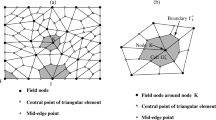Abstract
Kinematic and static analysis of geotechnical problems using the DEM has been widely accepted in the research arena for many years; however, its routine use in geotechnical practice for slope stability analysis still remains limited. This study focuses on the behavior of cohesive soil slopes undergoing failure initiation and succedent run-out. The numerical simulations of a supposititious slope composed of homogeneous cohesive soil were conducted using the DEM. The cohesive soil was simulated using contact-bonded graded aggregates of diameters ranging from 80 to 160 mm. This study investigated the microcrack-growth, particle displacements, particle movement and porosity changes within the slope fill. The simulation results showed that the failure mechanism is a rotational one at the failure initiation stage and gradually transfer to a slide/flow mode as progressive failure occurs. The porosity of deposit mass increased remarkably as result of dilation and block void. The run-out behavior of failure mass is not very sensitive with the viscous damping constant.










Similar content being viewed by others
References
Bardet JP, Proubet J (1991) A numerical investigation of the structure of persistent shear bands in granular media. Geotechnique 41(4):599–613
Bertrand D, Nicot F, Gotteland P, Lambert S (2005) Modelling a geo-composite cell using discrete analysis. Comput Geotech 32:564–577
Bhandari A, Han J (2010) Investigation of geotextile–soil interaction under a cyclic vertical load using the discrete element method. Geotext Geomembr 28:33–43
Bourrier F, Nicot F, Darve F (2008) Physical processes within a 2D granular layer during an impact. Granul Matter 10:415–437
Campbell CS, Cleary PW, Hopkins M (1995) Large-scale landslide simulations: global deformation, velocities and basal friction. J Geophys Res 100(B5):8267–8283
Chareyre B, Villard P (2005) Dynamic spar elements and DEM in two dimensions for the modelling of soil-inclusion problems. J Eng Mech 131(7):689–698
Cheng YP, Nakata Y, Bolton MD (2003) Discrete element simulation of crushable soil. Geotechnique 53(7):633–641
Crosta G, Calvetti F, Imposimato S, Roddeman D, Frattini P, Agliardi F (2001) Granular flows and numerical modelling of landslides. Report of Damocles Project EVG1-CT-1999-00007
Cundall PA (1999) Numerical experiments on rough joints in shear using a bonded particle model. Lecture notes in earth sciences. Springer, Berlin
Cundall PA, Strack O (1979) A discrete numerical model for granular assemblies. Geotechnique 29(1):47–65
Dawson EM, Roth WH, Drescher A (1999) Slope stability analysis by strength reduction. Geotechnique 49(6):835–840
Han J, Bhandari A, Wang F (2012) DEM analysis of stresses and deformations of geogrid-reinforced embankments over piles. Int J Geomech 12(4):340–350
Itasca Consulting Group Inc (2008) PFC2D particle flow code in 2 dimensions user’s guide. Itasca Consulting Group Inc, Minneapolis
Karal K (1977) Energy method for soil stability analyses. J Geotech Eng Division 103(GT5):431–445
Li WC, Li HJ, Dai FC, Lee LM (2012) Discrete element modeling of a rainfall-induced flowslide. Eng Geol 149–150:22–34
Liu Z, Koyi HA (2013) Kinematics and internal deformation of granular slopes: insights from discrete element modeling. Landslides 10(2):139–160
Lo CM, Lin ML, Tang CL, Hu JC (2011) A kinematic model of the Hsiaolin landslide calibrated to the morphology of the landslide deposit. Eng Geol 123:22–39
Nadukuru SS, Michalowski RL (2012) Arching in distribution of active load on retaining walls. J Geotech Geoenviron Eng 13(5):575–584
Nicot F, Gotteland P, Bertrand D, Lambert S (2007) Multiscale approach to geo-composite cellular structures subjected to rock impacts. Int J Numer Anal Meth Geomech 31:1477–1515
Potyondy DO, Cundall PA (2004) A bonded-particle model for rock. Int J Rock Mech Min Sci 41(8):1329–1364
Salciarini D, Tamagnini C, Conversini P (2010) Discrete element modeling of debris–avalanche impact on earthfill barriers. Phys Chem Earth 35:172–181
Stahl M, Konietzky H, Kamp L, Jas H (2013) Discrete element simulation of geogrid-stabilised soil. Acta Geotech. doi:10.1007/s11440-013-0265-0
Staron L, Hinch EJ (2005) Study of the collapse of granular columns using two dimensional discrete-grain simulation. J Fluid Mech 545:1–27
Tang CL, Hu JC, Lin ML, Angelier J, Lu CY, Chan YC, Chu HT (2009) The Tsaoling landslide triggered by the Chi-Chi earthquake, Taiwan: insights from a discrete element simulation. Eng Geol 106:1–19
Teufelsbauer H, Wang Y, Pudasaini SP, Borja RI, Wu W (2011) DEM simulation of impact force exerted by granular flow on rigid structures. Acta Geotech 6:119–133
Thompson N, Bennett MR, Petford N (2009) Analyses on granular mass movement mechanics and deformation with distinct element numerical modeling: implications for large-scale rock and debris avalanches. Acta Geotech 4:233–247
Utili S, Nova R (2008) DEM analysis of bonded granular geomaterials. Int J Numer Anal Methods Geomech 32:1997–2031
Wang J, Yan H (2013) On the role of particle breakage in the shear failure behavior of granular soils by DEM. Int J Numer Anal Methods Geomech 37:832–854
Wang C, Tannant DD, Lilly PA (2003) Numerical analysis of the stability of heavily jointed rock slopes using PFC2D. Int J Rock Mech Min 40:415–424
Wang J, Gutierrez MS, Dove JE (2007a) Numerical studies of shear banding in interface shear tests using a new strain calculation method. Int J Numer Anal Methods Geomech 31:1349–1366
Wang J, Dove JE, Gutierrez MS (2007b) Discrete-continuum analysis of shear banding in the direct shear test. Geotechnique 57(6):513–526
Zhang L, Thornton C (2007) A numerical examination of the direct shear test. Geotechnique 57(4):343–354
Acknowledgements
The authors acknowledge the financial support from the National Key Basic Research Program of China (Project No. 2013CB733201), the STS project of CAS (Project No. KFJ-EW-STS-094), the “hundred talents” program of CAS (Su Lijun) and the National Natural Science Foundation of China (Grants 41472293, 91430105). These supports are greatly appreciated.
Author information
Authors and Affiliations
Corresponding author
Rights and permissions
About this article
Cite this article
Li, X., Wu, Y. & Su, L. Initiation and Displacement Analysis of Cohesive Soil Slopes by Discrete Element Modelling. Geotech Geol Eng 35, 693–705 (2017). https://doi.org/10.1007/s10706-016-0134-3
Received:
Accepted:
Published:
Issue Date:
DOI: https://doi.org/10.1007/s10706-016-0134-3




